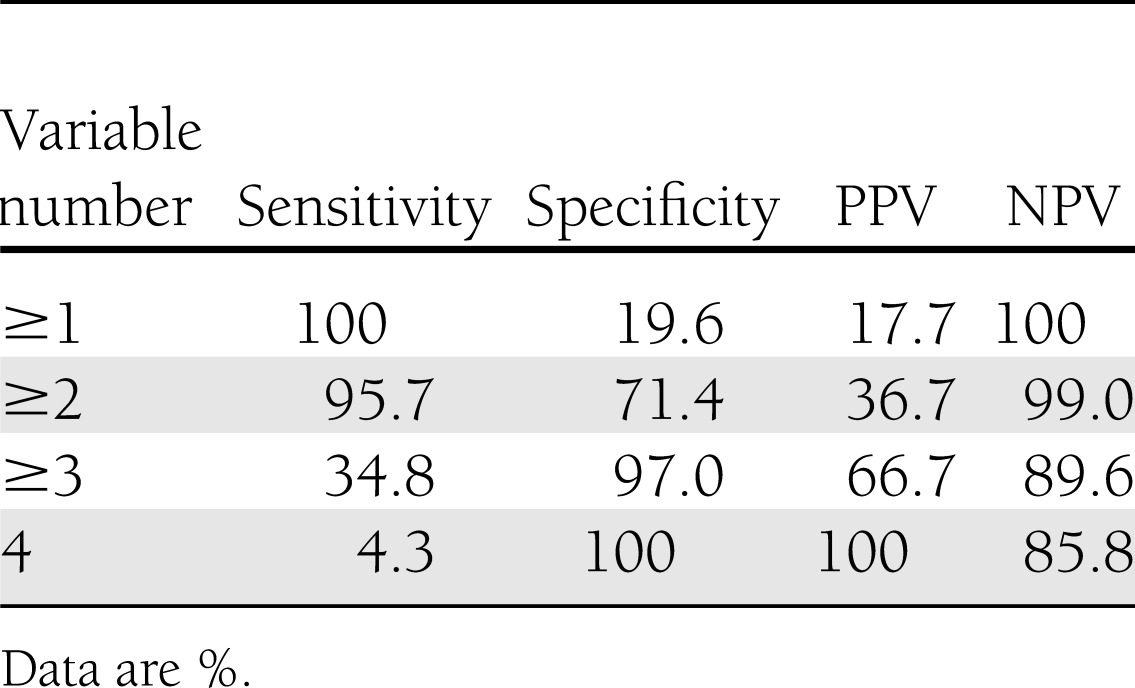Hyperglycemic crises present a disease continuum of diabetic emergency. There are three types of hyperglycemic crisis in clinical practice: 1) diabetic ketoacidosis (DKA), 2) hyperosmolar hyperglycemic state (HHS), and 3) mixed DKA/HHS (1,2). The prevalence of diabetes in the elderly is extremely high and growing (3–5). The elderly also have a higher mortality risk for hyperglycemic crises; therefore, it is particularly important to identify patients at risk within the geriatric population because early detection and intervention are beneficial (3–5). We investigated independent mortality predictors in geriatric patients with hyperglycemic crises and combined these predictors to predict the prognosis.
This study was conducted in a university-affiliated medical center. Consecutive elderly (≥65 years) patients who visited our emergency department between January 2004 and December 2010 were prospectively enrolled when they met the criteria of a hyperglycemic crisis (1). One hundred and fifty-six elderly patients were enrolled. We used 30-day mortality as the primary end point. Our study was organized as follows: we 1) identified univariate correlates of death in geriatric patients with hyperglycemic crises, 2) performed multivariate analyses and identified independent mortality predictors, and 3) combined the independent mortality predictors to predict the prognosis.
Age itself was not an independent mortality predictor (P = 0.095). Infection (odds ratio [OR], 38.69 [95% CI 4.09–365.72]), absent tachycardia (heart rate ≤100 bpm) (OR 14.06 [95% CI 3.68–53.77]), cancer history (OR 8.86 [95% CI 2.23–35.29]), and severe coma (Glasgow Coma Scale ≤8) (OR 5.28 [95% CI 1.53–18.21]) were independently associated with 30-day mortality. Table 1 shows that the presence of at least one of the four predictors had a sensitivity of 100% (95% CI 82.2–100), specificity of 19.6% (95% CI 13.4–27.5), positive predictive value (PPV) of 17.7% (95% CI 11.8–25.6), and negative predictive value (NPV) of 100% (95% CI 84.1–100). With at least two of these predictors present, the sensitivity was 95.7% (95% CI 76.0–99.8), the specificity was 71.4 (95% CI 62.8–78.8), the PPV was 36.7% (95% CI 24.9–50.2), and the NPV was 99.0% (95% CI 93.5–100). With at least three of these predictors present, the sensitivity was 34.8% (95% CI 17.2–57.2), the specificity was 97.0 (95% CI 92.0–99.0), the PPV was 66.7% (95% CI 35.4–88.7), and the NPV was 89.6% (95% CI 83.1–93.9). With all four predictors present, the sensitivity was 4.3% (95% CI 0.2–24.0), the specificity was 100.0 (95% CI 96.5–100.0), the PPV was 100.0% (95% CI 5.5–100.0), and the NPV was 85.8% (95% CI 79.1–90.7).
Table 1.
Sensitivity, specificity, PPV, and NPV of the number of independent mortality predictors for 30-day mortality

The mortality risk apparently rises with the number of independent mortality predictors. Zero percent mortality was found in the patients without any of the predictors. In the patients with all four predictors, 100% died. This finding may help physicians make decisions about the geriatric patients with hyperglycemic crises. In patients with a higher mortality risk, aggressive intervention, including admission to the intensive care unit, should be considered. For patients with lower mortality risk, a general ward admission or treatment in an emergency department may be sufficient, which would help preserve medical resources for patients in greater need.
Acknowledgments
This study was supported by grant CMNCKU10216 from the Chi-Mei Medical Center.
No potential conflicts of interest relevant to this article were reported.
C.-C.H. conceived the study concept and design, acquired data, performed statistical analysis, analyzed and interpreted data, wrote the manuscript, reviewed and edited the manuscript, and read and approved the final manuscript. T.-W.C. performed statistical analysis, analyzed and interpreted data, reviewed and edited the manuscript, and read and approved the final manuscript. S.-B.S. and H.-R.G. reviewed and edited the manuscript and read and approved the final manuscript. W.-L.C., J.-H.C., and S.-H.C. acquired, analyzed, and interpreted data and read and approved the final manuscript. H.-J.L. and Y.-F.W. conceived the study concept and design, acquired data, performed statistical analysis, analyzed and interpreted data, wrote the manuscript, reviewed and edited the manuscript, and read and approved the final manuscript. C.-C.H. is the guarantor of this work and, as such, had full access to all the data in the study and takes responsibility for the integrity of the data and the accuracy of the data analysis.
References
- 1.Kitabchi AE, Umpierrez GE, Miles JM, Fisher JN. Hyperglycemic crises in adult patients with diabetes. Diabetes Care 2009;32:1335–1343 [DOI] [PMC free article] [PubMed] [Google Scholar]
- 2.Wachtel TJ, Tetu-Mouradjian LM, Goldman DL, Ellis SE, O’Sullivan PS. Hyperosmolarity and acidosis in diabetes mellitus: a three-year experience in Rhode Island. J Gen Intern Med 1991;6:495–502 [DOI] [PubMed] [Google Scholar]
- 3.Meldon SW, Ma OJ, Woolard R. Geriatric Emergency Medicine. 1st ed. New York, McGraw-Hill, 2004, 394–401 [Google Scholar]
- 4.Gaglia JL, Wyckoff J, Abrahamson MJ. Acute hyperglycemic crisis in the elderly. Med Clin North Am 2004;88:1063–1084 [DOI] [PubMed] [Google Scholar]
- 5.Malone ML, Gennis V, Goodwin JS. Characteristics of diabetic ketoacidosis in older versus younger adults. J Am Geriatr Soc 1992;40:1100–1104 [DOI] [PubMed] [Google Scholar]


